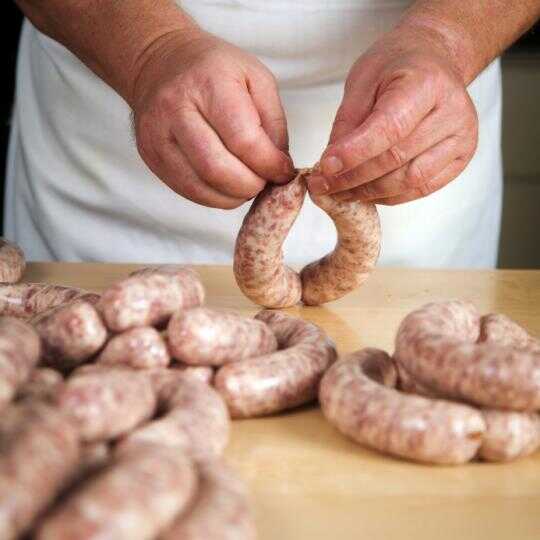
Aprenda a fazer linguiças em casa utilizando os equipamentos e procedimentos corretos para obter um resultado muito superior às linguiças oferecidas pelos grandes frigoríficos, que geralmente utilizam matéria prima não muito selecionada(retalhos), aditivos emulsificantes, proteínas vegetais, corantes, estabilizantes, conservantes e gordura em excesso. Conseguirá fazer a melhor linguiça que já comeu na vida.
Equipamentos
– Moedor de carne(disco com furos largos, de 10mm ou maior);
– Tripa natural suína, ovina ou tripa de colágeno;

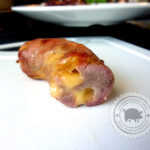
– Enchedor de linguiça(funil, manivela ou elétrico);
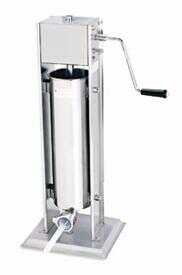 |
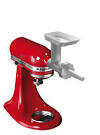 |
 |
– Balança de precisão, ideal que meça até as miligramas;
Temperos
A quantidade de sal varia muito do gosto individual, mas na regra utilize entre 5 g e 10 g de sal para cada 500 gramas de carne e gordura, ou seja, entre 1% e 2% do peso da linguiça de sal. Essa quantidade vai variar de acordo com a preferência, mas é recomendável iniciar o processo dentro dessa medida para evitar excessos.
Utilize preferencialmente temperos frescos, mas também obterá um bom resultado utilizando temperos secos, como alo em flocos, cebola desidratada, pimentas, orégano, gengibra em pó, louro em pó… ervas e especiarias secas, como orégano, manjericão, tomilho e etc devem ser esmagadas pouco antes da utilização para liberarem sabor. Ervas secas e temperos frescos podem conter contaminantes, então escolha bons fornecedores para evitar a contaminação do produto proveniente das ervas aromáticas.
No tempero reside toda a diversão do processo, pois é aqui que poderá utilizar sua criatividade para elaborar receitas únicas que darão personalidade à base de sua linguiça, que é a carne. A escolha da carne e dos temperos é a alma desta saborosa arte da charcutaria que é a produção de linguiças. Qual seria a graça de fazer uma linguiça igual ou parecida com a do supermercado? A liberdade criativa é a força motriz que nos compele a perder horas nesta prazerosa tarefa. Imaginar a suculência, a cor e o sabor de uma mistura única, botar a mão na massa e fazer a alquimia é desafio e deleite.
Temperos naturais funcionais
- Alho – bactericida e fungicida natural;
- Cebola – bactericida e fungicida natural;
- Alecrim – antioxidante natural, ideal utilizar extrato de alecrim ou óleo de alecrim;
- Aipo é uma fonte natural de nitrito de sódio(conservante e agente e cura);
- Beterraba – fonte de nitrito de sódio e corante natural;
- Limão – conservante acidulante natural.
Aditivos funcionais
- Sal de cura: usar ou não usar, leia os post Dicas para fazer linguiça caseira e Sal de cura o que é e quanto usar;
- Acelerador de cura: caso opte pelo uso do sal de cura é recomendável também usar algum acelerador, que pode ser o ácido ascórbico ou o eritorbato de sódio. Como alternativa natual é possível utilizar a cereja em pó como fonte de ácido ascórbico;
- Antioxidantes: extrato de alecrim é um ótimo agente antioxidante totalmente natural;
- Ligadores: para ajudar na ligação/bind, que é o potencial do produto em reter umidade e gordura, utilize proteínas vegetais, como soja, e/ou leite em pó. Além disso trabalhar a carne depois de cortada também ajuda a proteína na retenção de líquidos;
- Para mais informações leia o post Aditivos para embutidos
Procedimentos
Corte a carne em cubos, geralmente de 1cm de espessura ou de um tamanho adequado ao tamanho do bocal de entrada do moedor de carne utilizado. É possível “moer” a carne com uma faca bem afiada, mas o processo será bem mais demorado. Se tiver um moedor muito bom, com rosca larga e boca com furo de meia polegada, use-o pois o resultado provavelmente será muito satisfatório. Caso tenha um moedor de pequeno porte dê preferência para o uso da faca. Moedores pequenos podem estragar a textura da carne.
Antes de moer, é recomendável temperar a carne em cubos, com o sal, a pimenta, as ervas e especiarias que irá utilizar para dar sabor à linguiça. Deixe algumas horas na geladeira para que todos os temperos, principalmente o sal, sejam bem absorvidos e distribuídos uniformemente pela carne. Caso corte com a faca, tempere após cortar.
Mantenha sempre tudo gelado
É importante manter a carne o mais frio possível durante todo o processo de produção de linguiças, pois se a carne esquentar muito durante a produção a gordura irá separar. E quanto menos a gordura se soltar, melhor, pois o produto final será uma linguiça mais suculenta. Pode-se deixar num temperatura próxima do congelamento para depois proceder com a moagem ou corte.
Ao cortar a carne, remova o máximo de nervos, pois estes podem ficar presos nos discos durante a moagem e alterar a textura da carne.
Misture bem
Após executada a moagem, misture vigorosamente a carne para que a proteína seja bem trabalhada, pode-se adicionar algum líquido bem gelado nesta etapa, como vinho, suco ou até mesmo gelo, só não esqueça de que é importante que tudo fique bem incorporado na mistura. Adicionar líquidos aumenta a umidade do produto final.
O importante é não deixar a carne quebradiça, é preciso obter uma mistura bem homogênea, pegajosa, pois desta forma a linguiça ficará com uma consistência mais firme. Pode-se misturar com a mão ou com uma batedeira com o batedor de pá plana ou gancho, veja qual se adapta melhor com seu equipamento. O importante é misturar bem até que a mistura fique pegajosa.
Enchendo a tripa
Tripas naturais são salgadas e precisam ficar de molho em água fria por, pelo menos, 30 minutos. Após este período enxague bem, em água corrente, a parte interna da tripa.
Caso não tenha equipamento específico para embutir, não há problema, use um funil e os dedos ou o cabo de uma colher de pau.
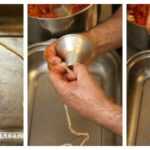
Caso tenha uma ensacadeira/canhão para embutir linguiça, insira toda a tripa no bico do enchedor e vá embutindo tentando evitar a formação de bolhas de ar.
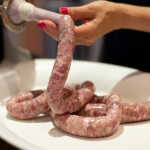
Assim que toda a tripa estiver recheada, aperte e gire para dividir e prender as partes separadas. Gire alternando as direções ou amarre com um barbante. Caso observe bolhas de ar nas linguiças, fure-as com uma agulha.
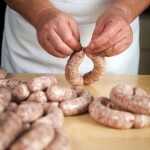
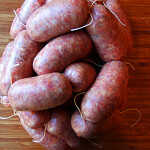
Leia também Dicas para fazer linguiça caseira
-
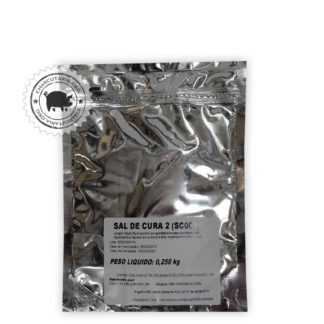 Sal de cura 2R$ 8,00
Sal de cura 2R$ 8,00 -
 Sal de cura 1R$ 8,00
Sal de cura 1R$ 8,00 -
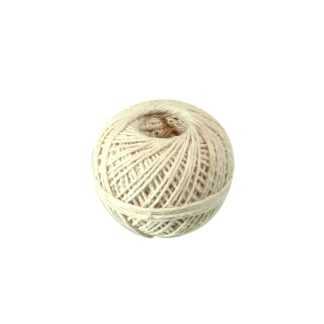 Barbante culinárioR$ 7,90
Barbante culinárioR$ 7,90 -
 Tripa suína natural para linguiçaR$ 52,00
Tripa suína natural para linguiçaR$ 52,00 -
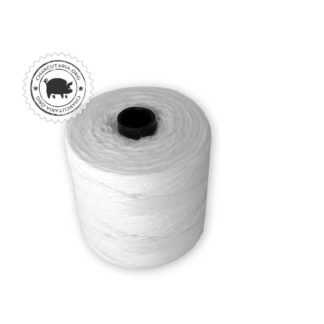 Barbante culinário poliésterR$ 18,00
Barbante culinário poliésterR$ 18,00 -
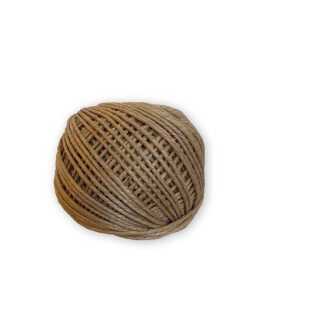 Barbante encerado ramiR$ 14,00
Barbante encerado ramiR$ 14,00 -
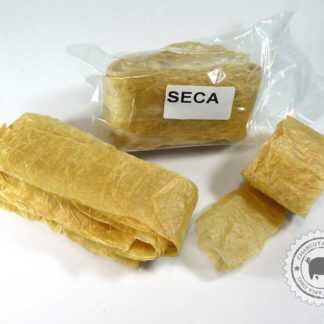 Tripa Bovina SecaO preço original era: R$ 19,00.R$ 15,00O preço atual é: R$ 15,00.
Tripa Bovina SecaO preço original era: R$ 19,00.R$ 15,00O preço atual é: R$ 15,00. -
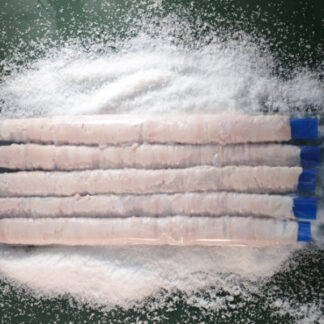 Tripa suína tubingR$ 39,00
Tripa suína tubingR$ 39,00 -
 Tripa de carneiro ovina 22/24R$ 75,00
Tripa de carneiro ovina 22/24R$ 75,00


Boa tarde!
Admiro muito este canal, estão de parabéns pelo conteúdo e artigos publicados.
Gostaria de tirar uma dúvida técnica: Por que há variação na coloração da tripa dos produtos industriais ( sadia, Perdigão, Seara,etc… dos produtos que produzimos em casa, numa escala bem menor.
Como deixar a tripa com uma aparência semelhante?
Oi Reginaldo. Talvez alguns dos produtos industriais utilizem algum corante natural ou fumaça líquida na composição, a tripa acaba absorvendo parte destes corantes e alterando a cor. Outra questão é que a tripa pode ser natural ou colágeno. As tripas naturais são sempre iguais, mas as de colágeno podem ter tons diferentes dependendo do fabricante. Qual seria o tom de cor que pretende chegar?
Olá Eduardo,
Obrigado por responder tão rápido.
Estou utilizando a tripa suína mesmo. Faz fiz vários testes utilizando corante e sem corante,
Percebi que a tripa utilizada na indústria mencionada anteriormente fica com aspecto bem branca , diferente do modo artesanal que tenho feito.
Gostaria de chegar próximo do que encontramos no mercado.
Reginaldo, experimente deixar de molho por uns 15 minutos em água com um pouco de vinagre.
Show de bola…
Farei isso!
Obrigado, Eduardo
Boa noite. Exelente o site, parabéns. Vou começar a fazer uma produção apenas para consumo mesmo, sei que tem que ter uma porcentagem de “gordura “. Qual gordura seria essa ? Somente suína? Porcentagem seria entre 15/20% correto? Não encontrei essas informações. Obrigado.
Máximo, a gordura extra adicionada geralmente provém do toucinho de porco, acrescido na proporção de 10% a 20%, dependendo do produto desejado. Mas muitas linguiças são feitas só com um corte de carne, como, por exemplo, uma linguiça 100% pernil. O pernil de porco geralmente já tem uma boa proporção de gordura. Portanto, pode variar muito conforme cada receita.
Entendi. Mas se por exemplo fazer sem usar carne suína, de frango no caso colocaria a pele? A gordura da costela gaúcha serviria também? Obrigado pela atenção.
A gordura da costela bovina serve como fonte de gordura. A pele de frango também é uma ótima fonte de gordura. Podem ser usados para substituir a gordura adicional suína.
Boa noite, estou começando a fabricação de linguiça agora, já entendi bem o passo a passo e tudo mais, porém ainda fiquei em dúvidas em relação a conservação. Meu objetivo é fazer de 3 a 5 kg de massa por vez, para consumo próprio, somente com sal e tempero, sem adição de químicos ou até mesmo o sal de cura. Após pronta a linguiça, posso armazenar diretamente no freezer ou recomenda-se esfriar em geladeira antes? Guardando elas no freezer, o prazo de validade ideal para consumo é em torno de 30 dias? Muito bom o site, me ajudou bastante, conteúdo excepcional, parabéns!
Oi Rodrigo. O ideal é refrigerar e depois congelar. Vai durar por volta de 90 dias no congelador.
Uma polegada e meia
Queria saber esse disco de meia polegada. Meia que número é 10 ou 8 aqui eu faço com 6
10mm
[…] podemos citar os presuntos, salames, terrines, patês, mortadela, pastrame, copa, bacon, salsichas, linguiças, carne de sol, todas as carnes preservadas com sal, na gordura(confit), defumadas e […]
Boa tarde, qual o melhor equipamento para fazer linguiça em casa, consumo próprio ?
É preciso adicionar algum aditivo artificial ?
Grato.
Para fazer em casa só precisa de uma boa faca e de um funil largo para embutir. Já é possível fazer só com isso. Caso queira mais produtividade use uma ensacadeira de linguiças de pequeno porte e um moedor manual, com um disco(furos frontais) largos, com furos de 10mm ou mais de diâmetro.
Sobre os aditivos é sempre recomendável usar o mínimo de sal de cura e antioxidante, mas para consumo próprio e imediato(até 3 dias) é opcional.
Gosto de comer defumadas,ai pergunto,qual o tempo mínimo de defumação e temperatura?
O tempo de defumação varia de acordo com o tipo e a espessura do produto. O ideal é medir a temperatura interna do produto e ao chegar em 65ºC estará pronto. Uma temperatura boa para defumação quente é 90ºC.
Boa noite ! Tem alguma tabela de indicação qual disco usar para determinadas linguiças e tabela com tamanho de tripa para cada tipo de linguiça e salame .Atenciosamente Johan
Oi Johan. Sobre as tripas temos a tabela das tripas neste post: https://charcutaria.org/diversos/como-preparar-a-tripa-natural/
Dos discos não temos as referências.
Olá
Estou comprando o frango inteiro para fazer a linguiça de frango, porém preciso de uma planilha de desossa para saber se vale a pena comprar o frango ou os produtos separados no caso o file de peito e file de cosa. Lembrando que no caso do frango inteiro vou usar as outras partes para venda separada. Preciso de uma planilha com os calculos de perda e percentuais.
Quando eu uso o sal de cura tipo 1 , é necessário usar o sal comum? guardando as devidas medidas para não ultrapassar o limite.
Oi Mário. Sim, deve usar apenas 2,4g do sal de cura 1 e o restante de sal comum para dar o ponto do sal correto.
Quais os aditivos posso usar para reter a água da massa? Alias,quais os produtos (atitivos) devo usar para ter uma boa linguiça, eles podem ser misturados com os naturais?
Fosfatos, proteínas vegetais e amidos. Veja este produto que tem esta finalidade: https://charcutaria.org/produto/emulsificante-estabilizante-carneo-embutidos-rendimento/
Tenho uma dúvida:
Porque não posso usar as carnes que já forão congeladas?
Tem fornecedores que trabalham com valores bem em conta porém produtos congelados.
Oi Mário, pode usar carne congelada. O ideal é a carne fresca, mas vai dar certo com a congelada também.
Obrigado, Qual produto (Aditivo) uso para reter a água da massa? Alias, quais os produtos (atitivos) devo usar para ter uma boa linguiça, eles podem ser misturados com os naturais?
Olá
Gostaria de saber qual o melhor moedor de carne manual?
Seria um produto fabricado com:
1- Alumìnio
2- Ferro Fundido
3- Metal
Oi Mário, o ideal é aço inox, mas geralmente são mais caros. Depois o alumínio é melhor pois não vai te dar manutenção por ferrugem. Ferro e outras ligas metálicas vão enferrujar caso não desmonte e seque muito bem antes de guardar.
Boa tarde! Para é possível misturar a carne manualmente até chegar na mistura homogênea ou precisa de algum equipamento para esse processo? Se sim, qual poderia ser?
OBS: o site de vocês é sensacional, parabéns!
Oi Clara, pode sim fazer manualmente, misture bem com as mãos até a massa ficar grudenta. Com relação aos equipamentos, pode ser uma batedeira orbital ou uma misturadeira de massa, como as usadas para pão.
olá estou procurando sobre o mercado de linguiça artesanal, achei a pagina de vocês bem legal. vocês indicam algum curso no Rj?
também gostaria de saber mais ou menos a validade do produto após embalada a vácuo
Desconheço curso no RJ. Sobre a validade pode procurar produtos similares de frigoríficos nos mercados e usar como referência. Para a linguiça fresca de pernil à vácuo na geladeira a durabilidade vai ficar por volta de 30 dias, mas avalie a receita comparando com outros produtos no mercado.
Bom dia
Parabéns pelo site , tirei muitas duvidas ! Excelente
Ajudou a me inspirar
Olá. Bom dia!
Após produzir a linguiça, caso embale a mesma no sistema a vácuo o tempo de conservação aumenta? Em caso positivo cerca de quanto tempo? Grato.
Oi Carlos, no vácuo a validade aumenta sim. No vácuo bem refrigerada vai durar por volta de 30 dias. Fora do vácuo em um pote fechado, por exemplo, vai durar entre 7 e 15 dias no máximo. Mas cada receita pode ter uma validade diferente pois o conjunto de condimentos e o processo em sí alteram a durabilidade. Procure produtos similares de frigoríficos no mercado para comparar. O ideal é congelar caso não vá consumir.
Olá boa tarde! Gosto de fazer as coisas que gosto de comer, porque passo mal com comidas feitas com produtos químicos. Tem uns 15 anos que dificilmente como na rua. Adoro comer linguiça com pão. Quando viajava pelo Brasil, era certo para em algum lugar para lanchar o famoso pão com linguiça. Mas hoje quando como, passo mal minutos depois. Então resolvi fazer a minha. Fiz, e só usei, alho, sal comum, salsa e cebolinha, um pouco de limão e nenhum corante. Estudando sobre o urucum, é provável que da próxima vez eu use um pouco para dar um corzinha. Ela ficou bonita. Porem como sou muito detalhista, não gostei muito do sabor. Fiz de diversas formas. Frita com com cebola, para comer com pão e no feijão, foi o que mais agradou. A pergunta é: Eu sou obrigado a usar o sal de cura? Eu não quero fazer uso do Sal de Cura! Quero dar o tom de mais natural possível, porem com sabor. Deixei a carne temperada por um dia. Fiz certo? Uma coisa que tenho certeza que errei, porque não gostei do resultado. É que, como marinheiro de primeira viagem, eu moí a carne. Mas agora, tem… Leia mais »
Oi Jorge, o uso do sal de cura só é obrigatório para produtos que são comercializados. Caso vá fazer para consumo próprio não há obrigação, apenas a recomendação pois o sal de cura inibe a proliferação da bactéria geradora da toxina botulínica. Sem o sal de cura certifique-se de usar uma quantidade de sal que garanta boa proteção(2% ou +) e uma fonte de acidez(vinho, ácido cítrico, vinagre e etc).
gostaria sabe qual moedor senhor indicar. esse seria uma boa opção Moedor de Carne Elétrico Preto Britânia 127v ?
Moedores de pequeno porte podem servir para salame, mas para linguiças tipo churrasco, por exemplo, não prestam. Vão moer demais a carne e danificar a textura das linguiças. Caso queira fazer salame ou outros produtos onde a carne é mais processada, como salsichas, então esses moedores pequenos servem. Caso contrário adquira um moedor com boca 8 ou maior.
oi, se eu optar em não usar o sal de cura e congelar logo em seguida pós ensacamento, em quanto tempo devem ser consumidas?
Oi Cristiano, vai durar por volta de 3 meses no congelador. A ausência do sal de cura neste caso não fará muita diferença na proteção, mas a coloração tende a não ficar avermelhada, que é uma característica conferida pela ação do sal de cura. Talvez tenha que acrescentar um corante caso queira a carne das linguiças mais vermelinhas.
Qual a proporção de tempero global pra cada jiló de carne.?????
Não conheço esse tempero pronto então não consigo te ajudar. Geralmente vem a instrução na embalagem.
Como posso usar o tempero pronto pra linguiça! Aquele GLOBAL IBRAC ….qual a proporção do tempero pra cada jiló de carne?
Não conheço esse tempero pronto então não consigo te ajudar. Geralmente vem a instrução na embalagem.
Eduardo, voltei, já comecei uma pequena produção de linguiça suína e tenho tido excelentes resultados e aceitação pelo mercado, agora estou legalizando o negócio mas estou esbarrando em um pequeno problema, capacidade de produção, não consigo ultrapassar os 50kg/dia no embutimento e vi que o gargalo é por a tripa no funil, já adquiri um funil mais estreito de 12mm de inox que imaginei reduzir o atrito tornando o ato de por a tripa mais fácil, mas não foi, continua com atrito, uso tripa 20/22 de carneiro. Tem alguma sugestão para melhorar essa etapa?
Obs.: Uso canhão de 5kg manual, mas não é ele o problema, deixo uma pontinha de carne no funil para ir lubrificando a parte interna na tripa, dessa forma reduzo um pouco o atrito e passei a usar fios longos (mais de 4 metros) dessa forma otimizo o tempo perdido em por a tripa no canhão.
Oi José de Padua. Parabéns pela produção! É uma questão de pratica, vai ficando cada vez mais produtivo, mas tem um limite de produtividade. Talvez uasndo dois funis, com uma pessoa enchendo as linguiças e outra colocando a tripa no funil. A mais fina de carneiro é a mais difícil de trabalhar, consequentemente tem a menor produtividade. A alternativa seria a de colágeno, que tem muito mais produtividade, mas teria que testar a aceitação pela sua clientela. Abraços!
Olá Jose .
interessante o que vc descreve , to pesquinsando para comecar a produzir linguiças artesanais para venda direta , to cheio de duvidas , e pessoas como Vc que já deram o primeiro passo ajudam bastante
Olá! Tenho uma dúvida; poderiam me ajudar? Eu gostaria de aprender a fazer linguiças artesanais, mas, por optar por uma alimentação restritiva, queria fazê-las sem a adição de glutamato, fosfatos, antioxidantes, etc… É possível fazer linguiças sem esses ingredientes? Quais seriam as consequências?
Oi Luis, pode fazer sem nenhum aditivo, sem problemas. Deixará de ter alguns benefícios desses aditivos, como conservação prolongada, coloração avermelhada e retenção de umidade. A linguiça terá vida útil mais baixa, deve consumi-la em 3 ou 4 dias no máximo. Siga uma das receitas que disponibilizamos com passo a passo, apenas retira os aditivos. https://charcutaria.org/categoria/receitas/linguicas/
Ótimo! Muito obrigado 😉
[…] podemos citar os presuntos, salames, terrines, patês, mortadela, pastrame, copa, bacon, salsichas, linguiças, carne de sol, todas as carnes preservadas com sal, na gordura (confit), defumadas e etc. A […]
Uma comi uma linguiça que estava meio seca e muito gosto de cominho… certamente esta pessoa não viu esta receita, rsrsrs.
Parabéns!
Ótimo trabalho.
Achei também este site com boas comofazerlinguica.tk dicas de linguiça artesanal e gostei muto.
Como faz linguiça de peixe e os melhores temperos
Poderia me ajudar.comecei a fazer linguiça para tentar vender e ganhar um dinheirinho mais tive que parar porque a linguiça que eu estava fazendo quando posta para fritar ela se abre toda tentei por três vezes e desisti até achar alguém que possa me ajudar nem curso presencial para aprender a fazer linguiça no rj eu encontrei
Oi Rossi, quer que tente te ajudar a fazer a linguiça sem estourar ou quer uma indicação de curso? Se quer o curso, onde mora? É assim mesmo, não desanime, com alguns testes e aprendizado vai conseguir fazer um produto bom para vender.
Boa tarde, Estou com problemas sobre isso. tenho feito as linguiças e encho na tripa de colageno e elas estouram quando fritas no oleo. Entrei no site para procurar ajuda e informações e vi esse seu comentario. aqui na minha cidadenão tem curso. Gostaria que vc tentasse m eajudar.
Oi Andressa. O colágeno é mais rígido e consequentemente mais menos elástico e por isso aguenta menos expansão. Durante a cocção, seja na churrasqueira, forno ou frigideira, pode haver liberação rápida de vapor pelo excesso de calor. O vapor vai estufar e estourar a tripa. Outra questão é o calor excesivo no colágeno, que pode queimas e enfraquecer o invólucro. A linguiça deve ser assada em calor médio/baixo, nunca em fogo alto ou com incidência de chama. Tente reduzir o calor e assar a linguiça mais lentamente, provavelmente o problema cessará. A tripa natural aguenta um pouco mais pela elasticidade, mas também pode estourar com calor muito alto. Espero ter ajudado.
Enviei o contato de um curso no Rio de Janeiro para o seu e-mail, depois veja se consegue aulas com eles. Se não conseguir me avisa que tento algum outro lugar para te ajudar. Boa sorte e um grande abraço!
Eduardo ainda não consegui visualizar oque você me mandou sobre o curso para aprender a fazer linguiça
Oi Rossi, procure pelo Açougue Fiel de Caxias, pelo que soube ministram cursos. Acho que o endereço e telefone deles é Av. Pres. Vargas, 325 – Centro, Duque de Caxias – RJ – Telefone 21 27720227. Veja se consegue contato com eles.
Se poder me manda esse curso por email tambem.
Não tem as postila gostaria de atiqueri…
Pode baixar os livros e manuais gratuitos que disponibilizamos. É só fazer o cadastro e baixar pelo endereço https://charcutaria.org/categoria-produto/manuais/
Novamente parabéns pelas informações, ficamos muito gratos, tenho duvidas como deixar a morcilha branca bem consistente. Que receita me recomenda, Abraços.